Sargonid Dynasty › Silk Road » Ancient origins
Articles and Definitions › Contents
- Sargonid Dynasty › Antique Origins
- Silk Road › Ancient History
Ancient civilizations › Historical and archaeological sites
Sargonid Dynasty › Antique Origins
Definition and Origins
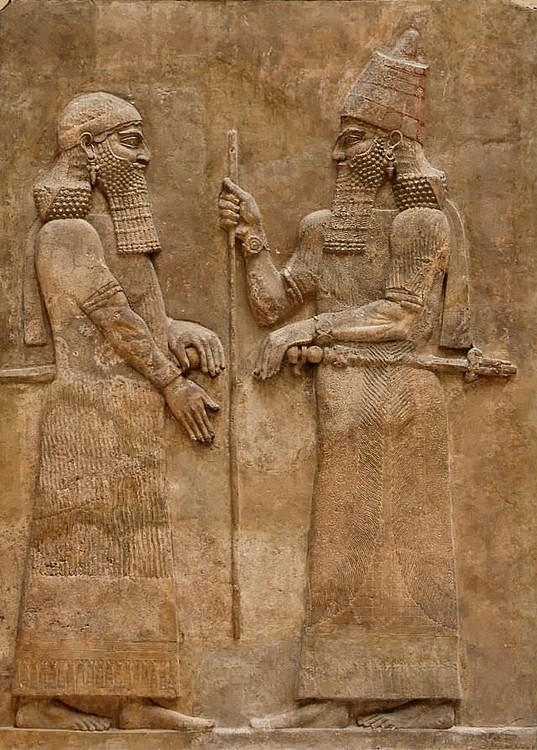
The Sargonid Dynasty was the last ruling house of the Neo-Assyrian Empire from 722-612 BCE. It began with the reign of Sargon II (reigned 722-705 BCE) and ended with fall of the Neo-Assyrian Empire in 612 BCE. Some of the most famous kings in the history of Assyria come from this dynasty, and the period in which they ruled is considered the high point of Assyrian culture and military power. The last great king was Ashurbanipal (reigned 668-627 BCE), most famous for his library at Nineveh ; following his death, his sons could not maintain the empire and it broke apart. Invading coalitions of those people who had felt oppressed by Assyrian rule ravaged the land and burned the cities and, afterwards, the territory was governed by these diverse cultures.
TIGLATH PILESER III & SHALMANESER V: PRE-SARGONID KINGS
Although the Sargonid Dynasty begins with Sargon II, he was provided with the resources to begin his successful reign by his father, Tiglath Pileser III (reigned 745-727 BCE), who reorganized the military and restructured the government. According to historian Simon Anglim, Tiglath Pileser III “carried out extensive reforms of the army, reasserted central control over the empire, reconquered the Mediterranean seaboard, and even subjugated Babylon. He replaced conscription [in the military] with a manpower levy imposed on each province and also demanded contingents from vassal states” (14). He defeated the kingdom of Urartu, which had again risen to trouble Assyrian rulers, and subjugated the region of Syria. According to some scholars, the Neo-Assyrian Empire actually begins with Tiglath Pileser III. The historian Gwendolyn Leick, for example, writes, “In the time between 745 and 705 BC, the Assyrian Empire took shape. This was the result not only of renewed military expansion but also of new administrative structures that ensured much tighter political and fiscal control” (127). Under Tiglath Pileser III's reign, the Assyrian army became the most effective military force in history up until that time and would provide a model for future armies in organization, tactics, training, and efficiency. It was the first professional army in the world that was able to fight year-round instead of only in the summer (between planting and harvest, when armies in the ancient period traditionally were conscripted), and this, in addition to their iron weapons, provided Assyria with a tremendous advantage over opponents.
ASHURBANIPAL SENT ENVOYS TO THE LANDS UNDER HIS CONTROL, WHERE THEY RETRIEVED OR COPIED THE BOOKS OF THAT TOWN, BRINGING ALL BACK TO NINEVEH FOR THE ROYAL LIBRARY.
Tiglath Pileser III was followed by Shalmaneser V (reigned 727-722 BCE) who continued the king's policies but was not as effective in military campaigns. He also seems to have been a poor administrator and judge of his people, as he overtaxed the populace and imposed forced labor even on the prestigious citizens of the city of Ashur (the former capital of the empire). His siege of Samaria and war with Israel dragged on, and his military expertise paled in comparison to his father's, whose successful campaigns were legendary. Shalmaneser V ruled for five years and then disappears from the historical record to be replaced by Sargon II. As there is no record of the death of Shalmaneser V and ample evidence of rebellions and unrest at the ascension of Sargon II, it seems clear the king was assassinated in a palace coup staged by his younger brother who was then reviled as a usurper of the throne.
SARGON II (REIGNED 722-705 BCE)
Sargon II's inscriptions refer to Shalmaneser V as his brother by blood (not "brother" in any honorary sense) but claim he was evil and did not keep the ways of the gods, and so the gods struck him down and elevated Sargon II. What historians believe happened was that Sargon II had inherited his father's skill in politics and military prowess and grew tired of watching his older brother's inept rule. Shalmaneser V would only have been chosen as heir because he was the oldest, not because he was the most able, and so Sargon II took it into his own hands to set things right. It is only from his own inscriptions that it is known he was the son of Tiglath Pileser III. There is no mention in court records or correspondence of Tiglath Pileser III's younger son, and Sargon II is unknown before he takes the throne and chooses "Sargon" as his throne name to link himself with the legendary Akkadian king Sargon the Great (2334-2279 BCE). The name "Sargon" means "true king" or "legitimate king" and, as Sargon the Great was a usurper who chose that name to legitimize his rule, it is thought that Sargon II may have been a usurper as well. Even though it has been accepted that he was the son of the great Tiglath Pileser III, this may not be so. The Assyrian court and territories of the empire erupted in rebellion when he took the throne and, to some scholars, this suggests he may not have been of noble blood.
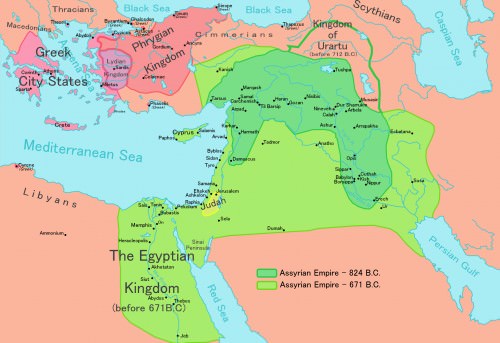
Neo-Assyrian Empire
Whoever he was and wherever he came from, Sargon II was a brilliant military leader and administrator who expanded the empire further than any king before him. His reign is considered the absolute peak of the Assyrian Empire and his campaigns were models of efficiency, brilliant military tactics, courage, and ruthlessness. Even though Sargon II's rule was contested by nobles who claimed he had seized the throne illegally, he maintained the cohesion of the empire, expanded the borders, improved legislation and administration, and kept the royal treasury filled through his conquests. His Urartu campaign of 714 BCE culminated in the sack of the wealthy temple of Haldi in the city of Mushashir, which added greatly to Assyria's wealth.Desiring a new capital from which to rule his empire, he ordered the construction of a new city, Dur-Sharrukin (“Fortress of Sargon”), which he oversaw the creation of personally. The historian Stephen Bertman comments on the city, writing :
Sargon's capital city was over a mile square and its design became his preoccupation. The city's dimensions, for example, were based on the numerological value of Sargon's name. Tablets describing the story of the palace's construction were deposited in its cornerstone with the identical text repeated on individual tablets of copper, lead, silver, gold, limestone, magnesite, and lapis lazuli, while paintings illustrated how cedar wood was imported from Lebanon to provide needed timber. Colossal stone bulls with wings and human heads guarded its entranceways. And the walls of the palace were decorated with so much sculpture that the panels, if laid end to end, would stretch for a mile (19).
The city took ten years to build, from 717-707 BCE, and Sargon II moved into his grand new palace in 706 BCE. Unfortunately for him, he was not to enjoy it for very long, as he was killed in battle with the Tabal people of Anatolia the next year in 705 BCE.

Sennacherib and the Fall of Lachish
SENNACHERIB (REIGNED 705-681 BCE)
He was followed by his son Sennacherib who campaigned with his army widely and ruthlessly, conquering Israel, Judah, and the Greek provinces in Anatolia. His siege of Jerusalem is detailed on the "Taylor Prism" (discovered in 1830 CE by Britain ’s Colonel Taylor), a cuneiform block describing Sennacherib's military exploits in which he claims to have captured 46 cities and trapped the people of Jerusalem inside the city until he overwhelmed them. His account is contested, however, by the version of events described in the biblical book of II Kings, chapters 18-19, II Chronicles 32:21, and Isaiah 37, where it is claimed that Jerusalem was saved by divine intervention and Sennacherib's army was driven from the field. The biblical account does relate the Assyrian conquest of the region, however.
Sennacherib's military victories increased the wealth of the empire beyond what Sargon II had accomplished, even though his reign was marred by persistent military campaigns against Babylon and the Elamites. After his father's death, he moved the capital from Sargon's city of Dur-Sharrukin to Nineveh and built what was known as “the Palace without a Rival”. He beautified and improved upon the city's original structure, planting orchards and gardens. The historian Christopher Scarre writes:
Sennacherib's palace had all the usual accoutrements of a major Assyrian residence: colossal guardian figures and impressively carved stone reliefs (over 2,000 sculptured slabs in 71 rooms). Its gardens, too, were exceptional. Recent research by British Assyriologist Stephanie Dalley has suggested that these were the famous Hanging Gardens, one of the Seven Wonders of the Ancient World. Later writers placed the Hanging Gardens at Babylon, but extensive research has failed to find any trace of them. Sennacherib's proud account of the palace gardens he created at Nineveh fits that of the Hanging Gardens in several significant details (231).
Babylon had been a persistent problem throughout Sennacherib's reign, however, and he finally grew tired of dealing with it.Ignoring the lessons of the past, and not content with his great wealth and the luxury of the city, Sennacherib drove his army against Babylon, sacked it, and looted the temples. As earlier in history with Tukulti-Ninurta I (1244-1208 BCE), the looting and destruction of the temples of Babylon was seen as the height of sacrilege by the people of the region and also by Sennacherib's sons who assassinated him in his palace at Nineveh in order to placate the wrath of the gods. Sennacherib had chosen his youngest son, Esarhaddon, to succeed him in 683 BCE, and this did not sit well with his older brothers. While their motive in murdering their father could well have been their desire for power (and to cut off their younger brother's hopes for the crown), they would have needed some kind of justification for the act, and their father's sack of Babylon provided the rationalization.

Human-headed Winged-bull
ESARHADDON (REIGNED 681-669 BCE)
Sennacherib's son Esarhaddon took the throne, defeated his brother's factions in a six-week civil war, and then executed his brother's families, associates, and anyone who had joined against him. With his rule now secure, one of his first projects was to rebuild Babylon. He issued an official proclamation, which claimed that Babylon had been destroyed by the will of the gods owing to the city's wickedness and lack of respect for the divine. Nowhere in his proclamation does it mention Sennacherib or his role in the destruction of the city, but it makes clear that the gods chose Esarhaddon as the divine means for restoration: “Once during a previous ruler's reign there were bad omens. The city insulted its gods and was destroyed at their command.They chose me, Esarhaddon, to restore everything to its rightful place, to calm their anger, and soothe their rage.” The empire flourished under his reign. He successfully conquered Egypt which Sennacherib had tried and failed to do (because, according to Herodotus II.141, field mice ate through the strings of Sennacherib's archer's bows, their quivers, and the soldier's shield straps the night before battle). Esarhaddon established the empire's borders as far north as the Zagros Mountains (modern-day Iran) and as far south as Nubia (modern Sudan) with a span including the Levant (modern day Lebanon to Israel) through Anatolia ( Turkey ). His successful military campaigns, and careful maintenance of the government, provided the stability for advances in medicine, literacy, mathematics, astronomy, architecture, and the arts. Durant writes:
In the field of art, Assyria equaled her preceptor Babylonia and in bas-relief surpassed her. Stimulated by the influx of wealth into Ashur, Kalakh, and Nineveh, artists and artisans began to produce – for nobles and their ladies, for kings and palaces, for priests and temples – jewels of every description, cast metal as skilfully designed and finely wrought as on the great gates at Balawat, and luxurious furniture of richly carved and costly woods strengthened with metal and inlaid with gold, silver, bronze, or precious stones (278).
In order to secure the peace, Esarhaddon entered into vassal treaties with the Persians and the Medes, requiring them to submit in advance to his successor. Further, Esarhaddon's mother, Zakutu (c. 701-668 BCE) also issued a decree, known as the Loyalty Treaty of Naqia-Zakutu, which compelled the Assyrian court and the subject territories to accept Ashurbanipal as king and support his reign. This ensured the easy transition of power when Esarhaddon died preparing to campaign against the Nubians, and rule passed to the last great Assyrian king, Ashurbanipal.
ASHURBANIPAL (REIGNED 668-627 BCE)
Ashurbanipal was the most literate of the Assyrian rulers and is probably best known in the modern day for the vast library he collected at his palace at Nineveh. Though a great patron of arts and culture, Ashurbanipal could be just as ruthless as his predecessors in securing the empire and intimidating his enemies. The historian Paul Kriwaczek writes, “Which other imperialist would, like Ashurbanipal, have commissioned a sculpture for his palace with decoration showing him and his wife banqueting in their garden, with the struck-off head and severed hand of the King of Elam dangling from trees on either side, like ghastly Christmas baubles or strange fruit?” (208). He decisively defeated the Elamites, completed his father's conquest of Egypt (though Egypt would successfully throw off Assyrian rule), and expanded the empire further to the east and north. Elam had long posed a problem for the Assyrian Empire, and Ashurbanipal had already defeated them in battle once. In 648/647 BCE, Elam's king died and the country became divided by civil war as different factions fought for the throne. Ashurbanipal saw an opportunity to finally defeat his old enemy and drove his army again into Elam. The historian Susan Wise Bauer writes, “ Elamite cities burned. The temples and palaces of Susa were robbed. For no better reason than vengeance, Ashurbanipal ordered the royal tombs opened and the bones of the kings bundled off into captivity” (414). When he sacked and destroyed the city of Susa in 647 BCE, he left behind a tablet which recorded his triumph over the Elamites:
Susa, the great holy city, abode of their gods, seat of their mysteries, I conquered. I entered its palaces, I opened their treasuries where silver and gold, goods and wealth were amassed... I destroyed the ziggurat of Susa. I smashed its shining copper horns. I reduced the temples of Elam to naught; their gods and goddesses I scattered to the winds. The tombs of their ancient and recent kings I devastated, I exposed to the sun, and I carried away their bones toward the land of Ashur. I devastated the provinces of Elam and on their lands I sowed salt.
Anyone with even the slightest claim to the throne was captured and brought back to Nineveh as a slave. In keeping with Assyrian policy, Ashurbanipal then re-located enormous numbers of the population throughout the region and left the cities empty and the fields barren. Bauer writes, “Ashurbanipal did not rebuild after the wrecking of the country. He installed no governors, he resettled none of the devastated cities, he made no attempt to make this new province of Assyria anything more than a wasteland. Elam lay open and undefended” (414). This would later prove to be a mistake, as the Persians slowly took over the territory which had once been Elam and proceeded to re-build and fortify the cities. In time, they would help topple the Assyrian Empire.

Lion-hunting Scene, King Ashurbanipal
Just prior to Ashurbanipal's Elam campaign, his brother, Shamash -shum-ukin, who ruled Babylon, had revolted. He had secretly been in league with the Elamites and had actually encouraged their invasion of Assyria earlier in Ashurbanipal's reign.Ashurbanipal marched on Babylon and lay siege to the city for the next four years. Inscriptions from the time relate what the defenders of Babylon endured behind the walls: “They ate the flesh of their sons and daughters because of starvation.” When the city fell, those who had survived so long were cut down by the Assyrian soldiers and, Ashurbanipal writes, “The rest of those living I destroyed…and their carved-up bodies I fed to dogs, to pigs, to wolves, to eagles, to birds of the heavens, to fishes of the deep.” Shamash-shum-ukin set himself on fire in his palace in order to escape capture. Ashurbanipal then set an Assyrian government official named Kandalu on the throne of Babylon.
After the siege of Babylon and the destruction of Elam, Ashurbanipal turned his attention to one of his great interests: books.Recognizing the importance of preserving the past, he sent envoys to every point in the lands under his control and had them retrieve or copy the books of that city or town, bringing all back to Nineveh for the royal library. While not the first king to collect books, he was the first to make such a collection a priority. Ashurbanipal claimed to be able to read cuneiform script in both Akkadian and Sumerian and his collection of writings was vast. According to Kriwaczek, "Ashurbanipal went further than mere ability to read and claimed complete mastery of all the scribal arts" (250). In his own words, Ashurbanipal claimed:
I, Ashurbanipal, within the palace, understood the wisdom of Nabu [the god of learning]. All the art of writing of every kind. I made myself the master of them all. I read the cunning tablets of Sumer and the dark Akkadian language which is difficult to rightly use; I took my pleasure in reading stones inscribed before the flood. The best of the scribal art, such works as none of the kings who went before me had ever learnt, remedies from the top of the head to the toenails, non-canonical selections, clever teachings, whatever pertains to the medical mastery of [the gods] Ninurta and Gala, I wrote on tablets, checked and collated, and deposited within my palace for perusing and reading.
Kriwaczek further notes that this is no idle boast of the king, as there is actual proof that Ashurbanipal could compose in cuneiform and cites tablets which are signed by the author as "Ashurbanipal, King of Assyria". By the time of his death, his library would house over 30,000 clay tablets upon which were written some of the greatest masterpieces of Mesopotamian literature, including the epic tale of Gilgamesh and the Enuma Elish, the Babylonian tale of creation.
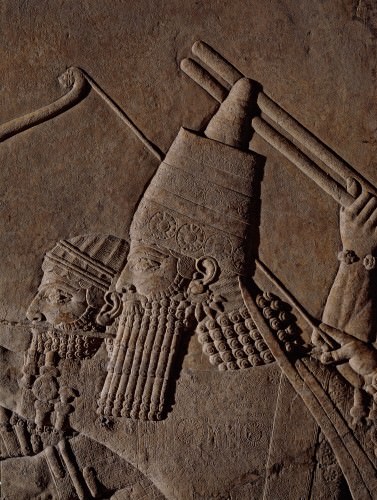
King Ashurbanipal
DECLINE & FALL
Ashurbanipal ruled over the empire for 42 years and, in that time, campaigned successfully and ruled efficiently. The empire had grown too large, however, and the regions were overtaxed. Further, the vastness of the Assyrian domain made it difficult to defend the borders. As great in number as the army remained, there were not enough men to keep garrisoned at every significant fort or outpost. When Ashurbanipal died in 627 BCE, the empire began to fall apart. His successors Ashur-etli-Ilani and Sin-Shar-Ishkun fought each other for the throne. While they were struggling for control of the empire, that very empire was slipping away. The territories under Assyrian rule saw their chance for independence and took it; regions began to successfully break away. The rule of the Assyrian Empire was seen as overly harsh by its subjects, in spite of whatever advancements and luxuries being an Assyrian citizen may have provided, and former vassal states rose in revolt.
In 612 BCE, Nineveh was sacked and burned by a coalition of Babylonians, Persians, Medes, and Scythians, among others (as was Ashur, Kalhu, and the other cities of the Assyrians). The destruction of the palace brought the flaming walls down on the library of Ashurbanipal and, although it was far from the intention, preserved the great library, and the history of the Assyrians, by baking hard and burying the clay tablet books. Kriwaczek writes, “Thus did Assyria's enemies ultimately fail to achieve their aim when they razed Ashur and Nineveh in 612 BCE, only fifteen years after Ashurbanipal's death: the wiping out of Assyria's place in history” (255). Still, the destruction of the great Assyrian cities was so complete that, within two generations of the empire's fall, no one knew where the cities had been.
The ruins of Nineveh were covered by the sands and lay buried for the next 2,000 years. The Sargonid Dynasty had brought the Assyrian Empire to its highest peak of success as a political and military entity but, as later with Rome, the empire had simply grown too large to maintain. Historians have speculated that this may be why Ashurbanipal never went back to re- conquer Egypt after it revolted against Assyrian rule; he may have understood that the empire was already too large to rule efficiently. He was the last king who was able to hold the empire together cohesively but, even if his sons had been better men and rulers, the empire could not have survived very much longer; it had simply grown too large and broke apart under the weight of that vast expanse.
Silk Road › Ancient History
Definition and Origins
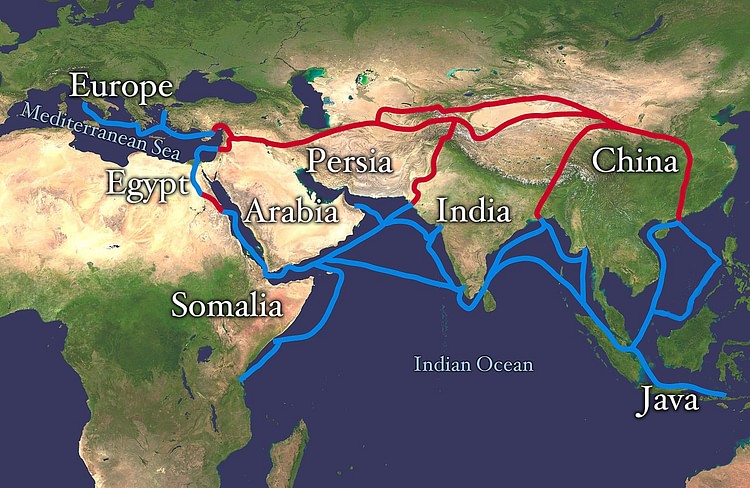
The Silk Road was an ancient network of trade routes, formally established during the Han Dynasty of China, which linked the regions of the ancient world in commerce between 130 BCE-1453 CE. As the Silk Road was not a single thoroughfare from east to west, the term 'Silk Routes' has become increasingly favored by historians, though 'Silk Road' is the more common and recognized name.
The European explorer Marco Polo (1254-1324 CE) traveled on these routes and described them in depth in his famous work but he is not credited with naming them. Both terms for this network of roads were coined by the German geographer and traveler, Ferdinand von Richthofen, in 1877 CE, who designated them 'Seidenstrasse' (silk road) or 'Seidenstrassen' (silk routes). Polo, and later von Richthofen, make mention of the goods which were transported back and forth on the Silk Road.
From West to East these goods included:
- Horses
- Saddles and Riding Tack
- The grapevine and grapes
- Dogs and other animals both exotic and domestic
- Animal furs and skins
- Honey
- Fruits
- Glassware
- Woolen blankets, rugs, carpets
- Textiles (such as curtains)
- Gold and Silver
- Camels
- Slaves
- Weapons and armor
From East to West the goods included:
- Silk
- Tea
- Dyes
- Precious Stones
- China (plates, bowls, cups, vases)
- Porcelain
- Spices (such as cinnamon and ginger)
- Bronze and gold artifacts
- Medicine
- Perfumes
- Ivory
- Rice
- Paper
- Gunpowder
The network was used regularly from 130 BCE, when the Han officially opened trade with the west, to 1453 CE, when the Ottoman Empire boycotted trade with the west and closed the routes. By this time, Europeans had become used to the goods from the east and, when the Silk Road closed, merchants needed to find new trade routes to meet the demand for these goods.
The closure of the Silk Road initiated the Age of Discovery (1453-1660 CE) which would be defined by European explorers taking to the sea and charting new water routes to replace over-land trade. The Age of Discovery would impact cultures around the world as European ships claimed some lands in the name of their god and country and influenced others by introducing western culture and religion and, at the same time, these other nations influenced European culture. The Silk Road - from its opening to its closure - had so great an impact on the development of world civilization that it is difficult to imagine the modern world without it.
PERSIAN ROYAL ROAD
The history of the Silk Road pre-dates the Han Dynasty in practice, however, as the Persian Royal Road, which would come to serve as one of the main arteries of the Silk Road, was established during the Achaemenid Empire (500-330 BCE). The Persian Royal Road ran from Susa, in north Persia (modern day Iran) to the Mediterranean Sea in Asia Minor (modern-day Turkey ) and featured postal stations along the route with fresh horses for envoys to quickly deliver messages throughout the empire. Herodotus, writing of the speed and efficiency of the Persian messengers, stated that:
There is nothing in the world that travels faster than these Persian couriers. Neither snow, nor rain, nor heat, nor darkness of night prevents these couriers from completing their designated stages with utmost speed. ( HistoriesVIII.98)
These lines would, centuries later, form the creed of the United States of America's post office. The Persians maintained the Royal Road carefully and, in time, expanded it through smaller side roads. These paths eventually crossed down into the Indian sub-continent, across Mesopotamia, and over into Egypt.
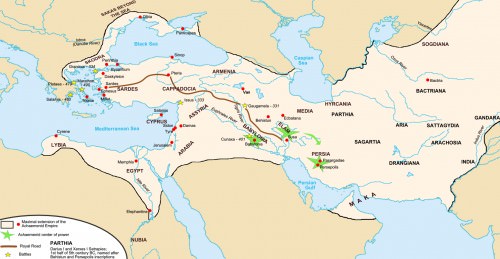
Persian Royal Road
CHINA & THE WEST
After Alexander the Great conquered the Persians, he established the city of Alexandria Eschate in 339 BCE in the Fergana Valley of Neb (modern Tajikistan). Leaving behind his wounded veterans in the city, Alexander moved on. In time, these Macedonian warriors intermarried with the indigenous populace creating the Greco-Bactrian culture which flourished under the Seleucid Empire following Alexander's death.
Under the Greco-Bactrian king Euthydemus I (260-195 BCE) the Greco-Bactrians had extended their holdings. According to the Greek historian Strabo (63-24 CE) the Greeks “extended their empire as far as the Seres” ( Geography XI.ii.i). `Seres' was the name by which the Greeks and Romans knew China, meaning `the land where silk came from'. It is thought, then, that the first contact between China and the west came around the year 200 BCE.
EMPEROR WU WAS EAGER TO GAIN NEW COMMODITIES THROUGH TRADE WITH THE WEST & THE SILK ROAD WAS OPENED IN 130 BCE.
The Han Dynasty of China (202 BCE – 220 CE) was regularly harassed by the nomadic tribes of the Xiongnu on their northern and western borders. In 138 BCE, Emperor Wu sent his emissary Zhang Qian to the west to negotiate with the Yuezhi people for help in defeating the Xiongnu.
Zhang Qian's expedition led him into contact with many different cultures and civilizations in central Asia and, among them, those whom he designated the `Dayuan', the `Great Ionians', who were the Greco-Bactrians descended from Alexander the Great's army. The Dayuan had mighty horses, Zhang Qian reported back to Wu, and these could be employed effectively against the marauding Xiongnu.
The consequences of Zhang Qian's journey was not only further contact between China and the west but an organized and efficient horse breeding program throughout the land in order to equip a cavalry. The horse had long been known in China and had been used in warfare for cavalry and chariots as early as the Shang Dynasty (1600 – 1046 BCE) but the Chinese admired the western horse for its size and speed. With the western horse of the Dayuan, the Han Dynasty defeated the Xiongnu. This success inspired Emperor Wu to speculate on what else might be gained through trade with the west and the Silk Road was opened in 130 BCE.
Between 171-138 BCE, Mithridates I of Parthia campaigned to expand and consolidate his kingdom in Mesopotamia. The Seleucid King Antiochus VII Sidetes (138-129 BCE) opposed this expansion and, also wishing revenge for the death of his brother, Demetrius, waged war against the Parthian forces of Phrates II, Mithridates successor. With the defeat of Antiochus, Mesopotamia came under Parthian rule and, with it, came control of the Silk Road. The Parthians then became the central intermediaries between China and the west.
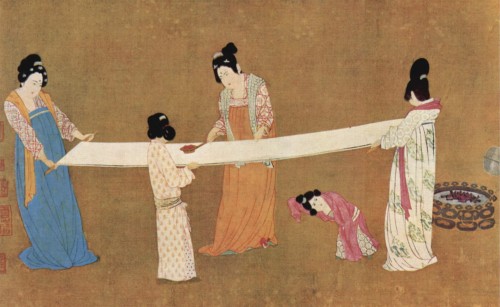
Women Checking Silk, Song China.
GOODS TRADED VIA THE SILK ROAD
While many different kinds of merchandise traveled along the Silk Road, the name comes from the popularity of Chinese silk with the west, especially with Rome. The Silk Road routes stretched from China through India, Asia Minor, up throughout Mesopotamia, to Egypt, the African continent, Greece, Rome, and Britain.
The northern Mesopotamian region (present-day Iran) became China's closest partner in trade, as part of the Parthian Empire, initiating important cultural exchanges. Paper, which had been invented by the Chinese during the Han Dynasty, and gunpowder, also a Chinese invention, had a much greater impact on culture than did silk. The rich spices of the east, also, contributed more than the fashion which grew up from the silk industry. Even so, by the time of the Roman EmperorAugustus (r.27 BCE – 14 CE) trade between China and the west was firmly established and silk was the most sought-after commodity in Egypt, Greece, and, especially, in Rome.
THE ROMAN LOVE OF SILK
Prior to becoming Emperor Augustus, Octavian Caesar seized on the controversial topic of silk clothing to denounce his adversaries Mark Antony (83-30 BCE) and Cleopatra VII (69-30 BCE) as immoral. As they both favored Chinese silk, which was increasingly becoming associated with licentiousness, Octavian exploited the link to deprecate his enemies. Octavian would triumph over Antony and Cleopatra ; he could do nothing, however, to curtail the popularity of silk.
The historian Will Durant writes:
The Romans thought [silk] a vegetable product combed from trees and valued it at its weight in gold. Much of this silk came to the island of Kos, where it was woven into dresses for the ladies of Rome and other cities ; in AD 91 the relatively poor state of Messenia had to forbid its women to wear transparent silk dresses at religious initiations. (329)
THE ISLAND OF KOS BECAME WEALTHY & LUXURIOUS THROUGH THEIR MANUFACTURE OF SILK CLOTHING.
By the time of Seneca the Younger (4 BCE – 65 CE), conservative Romans were more ardent than Augustus in decrying the Chinese silk as immoral dress for women and effeminate attire for men. These criticisms did nothing to stop the silk trade with Rome, however, and the island of Kos became wealthy and luxurious through their manufacture of silk clothing.
As Durant writes, " Italy enjoyed an 'unfavorable' balance of trade – cheerfully [buying] more than she sold” but still exported rich goods to China such as “carpets, jewels, amber, metals, dyes, drugs, and glass” (328-329). Up through the time of the emperor Marcus Aurelius (r.161-180 CE), silk was the most valued commodity in Rome and no amount of conservative criticism seemed to be able to slow the trade or stop the fashion.
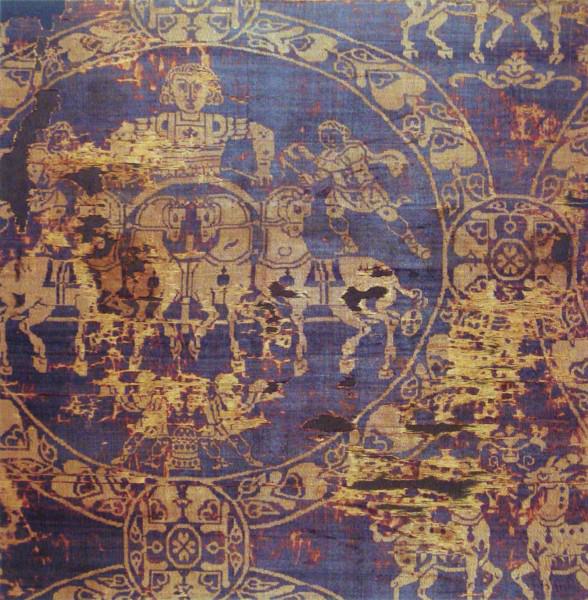
Tyrian Purple Shroud of Charlemagne
Even after Aurelius, silk remained popular, though increasingly expensive, until the fall of the Roman Empire in 476 CE. Rome was survived by its eastern half which came to be known as the Byzantine Empire and which carried on the Roman infatuation with silk. Around 60 CE the west had become aware that silk was not grown on the trees in China but was actually spun by silkworms. The Chinese had very purposefully kept the origin of silk a secret and, once it was out, carefully guarded their silkworms and their process of harvesting the silk.
The Byzantine emperor Justinian (527- 565 CE), tired of paying the exorbitant prices the Chinese demanded for silk, sent two emissaries, disguised as monks, to China to steal silkworms and smuggle them back to the west. The plan was successful and initiated the Byzantine silk industry. When the Byzantine Empire fell to the Turks in 1453 CE, the Ottoman Empire closed the Silk Road and cut all ties with the west.
THE SILK ROAD LEGACY
The greatest value of the Silk Road was the exchange of culture. Art, religion, philosophy, technology, language, science, architecture, and every other element of civilization was exchanged along these routes, carried with the commercial goods the merchants traded from country to country. Along this network disease traveled also, as evidenced in the spread of the bubonic plague of 542 CE which is thought to have arrived in Constantinople by way of the Silk Road and which decimated the Byzantine Empire.
The closing of the Silk Road forced merchants to take to the sea to ply their trade, thus initiating the Age of Discovery which led to world-wide interaction and the beginnings of a global community. In its time, the Silk Road served to broaden people's understanding of the world they lived in; its closure would propel Europeans across the ocean to explore, and eventually conquer, the so-called New World of the Americas. In this way, the Silk Road can be said to have established the groundwork for the development of the modern world.
LICENSE:
Article based on information obtained from these sources:with permission from the Website Ancient History Encyclopedia
Content is available under License Creative Commons: Attribution-NonCommercial-ShareAlike 3.0 Unported. CC-BY-NC-SA License